| [1] | A. Ram Rakhyani, S. Mirabbasi, and M. Chiao, “Design and optimization of resonance-based efficient wireless power delivery systems for biomedical implants”, Biomedical Circuits and Systems, IEEE Transactions on, vol. 5, no. 1, pp. 4863, Feb 2011. |
| [2] | S. Li, W. Li, J. Deng, and C. C. Mi, “A double-sided LCC compensation network and its tuning method for wireless power transfer”, IEEE Trans. Veh. Technol., vol. 64, no. 6, pp. 112, Jun. 2015. |
| [3] | Deepa Vincent, Phuoc Huynh Sang, and Sheldon S. Williamson, “Feasibility Study of Hybrid Inductive and Capacitive Wireless Power Transfer for Future Transportation”, Transportation Electrification Conference and Expo (ITEC), 2017 IEEE. |
| [4] | J. Dai and D. Ludois, “A Survey of Wireless Power Transfer and a Critical Comparison of Inductive and Capacitive Coupling for Small Gap Applications”, IEEE Trans. Power Electron., vol. 30, pp. 6011-6014, 2015. |
| [5] | J. Dai and D. Ludois, “Capacitive Power Transfer Through a Conformal Bumper for Electric Vehicle Charging”, IEEE Trans. Power Electron., vol. 30, no. 11, pp. 6017-6029, 2015. |
| [6] | C. Liu, A.P. Hu, N.C. Nair, “Modelling and Analysis of a Capacitively Coupled Contactless Power Transfer System”, IET Power Electron., vol. 4, no. 7, pp. 808-815, 2011. |
| [7] | L. Huang, A.P. Hu, A. Swain, “A Resonant Compensation Method for Improving the Performance of Capacitively Coupled Power Transfer”, IEEE Energy Conversion Congress and exposition (ECCE), pp.870-875, 2014. |
| [8] | S. Li, C. Mi, “Wireless Power Transfer for Electric Vehicle Applications”, IEEE Jour. of Emerg. and Selec. Top. on Power Electr. , vol. 3, no. 1 pp. 4-17, 2015. |
| [9] | F. Lu, H. Zhang, H. Hofmann, C. Mi, “A High Efficiency 3.3kW Loosely-Coupled Wireless Power Transfer System without Magnetic Material”, IEEE Energy Convers. Congr. Expo. (ECCE), pp. 2282-2286, 2015. |
| [10] | E.Culurciello, Andreou, “A. Capacitive Inter-Chip Data and Power Transfer for 3-D VLSI”, IEEE Trans. Circuit Syst. II, Vol. 53, pp. 13481352, 2006. |
| [11] | A. Sodagar, P. Amiri, “Capacitive Coupling for Power and Data Telemetry to Implantable Biomedical Microsystems”, IEEE Conference on Neural Engineering, Antalya, Turkey, 29 April 2 May 2009. |
| [12] | R. Jegadeesan, K. Agarwal, Y. Guo, S. Yen, N. Thakor, “Wireless Power Delivery to Flexible Subcutaneous Implants Using Capacitive Coupling”, IEEE Trans. Microw. Theory Tech., vol. 65, pp. 280-292, 2017. |
| [13] | D. Shmilovitz, A. Abramovitz and I. Reichman, “Quasi-Resonant LED Driver with Capacitive Isolation and High PF”, IEEE J. Emerg. Sel. Top. Power Electron., vol. 3, pp. 633641, 2015. |
| [14] | K. Wang, S. Sanders, “Contactless USBA Capacitive Power and Bidirectional Data Transfer System”, IEEE Applied Power Electronics Conference and Exposition, pp. 13421347, USA, 1620 March 2014. |
| [15] | T. Mostafa, A. Muharam and R. Hattori, “Wireless Battery Charging System for Drones via Capacitive Power Transfer”, IEEE Workshop on Emerging Technologies: Wireless Power Transfer, pp. 16, China, 2022 May 2017. |
| [16] | A.P. Hu, C. Liu and H. Li,“A novel Contactless Battery Charging System for Soccer Playing Robot”, International Conference on Mechatronics and Machine Vision in Practice, pp. 646650, Auckland, New Zealand, 24 December 2008. |
| [17] | Hua Zhang, Fei Lu, Heath Hofmann and Chris Mi, “A Loosely Coupled Capacitive Power Transfer System with LC Compensation Circuit Topology”, IEEE Energy Covers. Congr. Expo. (ECCE), pp. 1-5, 2016. |
| [18] | J. Dai, S. Hagen, D. Ludois and I. Brown, “Synchronous generator brushless field excitation and voltage regulation via capacitive coupling through journal bearing”, IEEE Trans. Ind. Appl., vol. 4, pp. 3317-3326, 2017. |
| [19] | Fei Lu, Hua Zhang and Chris Mi, “A Review on the Recent Development of Capacitive Wireless Power Transfer Technology”, Energies, vol. 10, pp. 1752, 2017. |
| [20] | I. Lee, J. Kim and W. Lee, “A high-efficient low-cost converter for capacitive wireless power transfer systems”, Energies, vol. 10, pp. 1473, 2017. |
| [21] | J. Dai and D. Ludois, “Single active switch power electronics for kilowatt scale capacitive power transfer”, IEEE J. Emerg. Sel. Top. Power Electron., vol. 3, pp. 315-323, 2016. |
| [22] | L. Huang, A.P Hu and A. Swain, “A resonant compensation method for improving the performance of capacitively coupled power transfer system”, IEEE 2014 Energy Conversion Congress and Exposition, pp. 870875, Pittsburgh, PA, USA, 2014. |
| [23] | B. Choi, D. Nguyen, S. Yoo, J. Kim and C.T. Rim, “A novel source-side monitored capacitive power transfer system for contactless mobile charger using class-E converter”, IEEE 79th Vehicular Technology Conference, pp. 15, Seoul, Korea, 2014. |
| [24] | R. Narayanamoorthi, A.V. Juliet, B. Chokkalingam, S. Padmanaban and Z.M. Leonowicz, “Class E power amplifier design and optimization for the capacitive coupled wireless power transfer system in biomedical implants”, Energies, vol. 10, pp. 1409, 2017. |
| [25] | D. Ludois, J. Reed and K. Hanson, “Capacitive power transfer for rotor field current in synchronous machines”, IEEE Trans. Power Electron. , vol. 27, pp. 46384645, 2012. |
| [26] | D. Ludois, M. Erickson and J. Reed, “Aerodynamic fluid bearings for translational and rotating capacitors in non-contact capacitive power transfer systems”, IEEE Trans. Ind. Appl., vol. 50, pp. 10251033, 2014. |
| [27] | Fei Lu, Hua Zhang, Heath Hofmann and Chris Mi, “A Loosely Coupled Capacitive Power Transfer with LC Compensation Topology”, IEEE Energy Convers. Congr. Expo (ECCE), pp. 1-5, 2016. |
| [28] | Fei Lu, Hua Zhang, Heath Hofmann and Chris Mi, “A Double-Sided LC Compensation Circuit for Loosely-Coupled Capacitive Power Transfer”, IEEE Trans. Power Electron., Vol. 33, no. 3, pp. 1633 - 1643, 2017. |
| [29] | M. Kusunoki, D. Obara and M. Masuda, “Wireless Power Transfer via Electric Field Resonance Coupling”, IEEE Asia-Pacific Microwave Conf. (APMC), pp. 1360-1362, 2014. |
| [30] | R.D Fernandes, J.N. Matos and N.B. Carvalho, “Wireless Power Transmission based on Resonant Electrical Coupling”, IEEE European Microwave Conference (EuMC), pp. 17- 20, 2014. |
| [31] | T. Komaru and H. Akita, “Positional Characteristics of Capacitive Power Transfer as a Resonance Coupling System”, IEEE Wireless Power Transfer conference. (WPTC)., pp. 218-221, 2013. |
| [32] | M. Kusunoki, D. Obara and M. Masuda, “Wireless power transfer via electric field resonance coupling”, In Proceedings of the IEEE Asia-Pacific Microwave Conference (APMC), Sendai, Japan, 47 November, pp. 13601362, 2014. |
| [33] | R.D. Fernandes, J.N. Matos and N.B. Carvalho, “Wireless power transmission based on resonant electrical coupling”, In Proceedings of the IEEE European Microwave Conference (EuMC), Rome, Italy, 69 October, pp. 1720, 2014. |
| [34] | B. Regensburger, A. Kumar, S. Sinha, K. Doubleday, S. Pervaiz, Z. Popovic and K. Afridi, “High performance large air-gap capacitive wireless power transfer system for electric vehicle charging”, In Proceedings of the IEEE 2017 Transportation Electrification Conference and Expo, Chicago, IL, USA, 2224 June, pp. 638643, 2017. |
| [35] | Hua Zhang, Fei Lu, Heath Hofmann and Chris Mi, “An LC Compensated Electric Field Repeater for Long Distance capacitive Power Transfer”, Energy Convers. Congr. Expo (ECCE), 2016. |
| [36] | T. Duerbaum, “First harmonic approximation including design constraints”, Telecommunications Energy Conference, INTELEC. Twentieth International, pp. 321328, 1998. |
| [37] | Hua Zhang, Fei Lu, Heath Hofmann and Chris Mi, “A 4-Plate Compact Capacitive Coupler Design and LCL-Compensated Topology for Capacitive Power Transfer in Electric Vehicle Charging Applications”, IEEE Trans. Power Electron., vol. 31, no. 12, pp. 8541-8551, 2016. |
| [38] | Deepak Rozario, Najath Abdul Azeez, and Sheldon S. Williamson, “Modified Resonant Converters for Capacitive Power Transfer Systems used for Battery Charging Applications”, IEEE Transportation Electrification Conference and Expo, USA, 2016. |
| [39] | Fei Lu, Hua Zhang, Heath Hofmann and Chris Mi, “A Double-sided LCLC-Compensated Capacitive Power Transfer System for Electric Vehicle Charger”, IEEE Trans. Power Electrn., Vol. 30, no. 11, pp. 6011-6014, 2015. |
| [40] | Fei Lu, Hua Zhang, Heath Hofmann and Chris Mi, “A CLLC-Compensated High Power and Large Air-Gap Capacitive Power Transfer System for Electric Vehicle Charging Applications”, IEEE Appl. Power Electr. Conf. (APEC), pp. 1721-1725, 2016. |
| [41] | Fei Lu, Hua Zhang and Chris Mi,“A Two-Plate Capacitive Wireless Power Transfer System for Electric Vehicle Charging Applications” IEEE Transactions on Power Electronics, vol. 33, pp. 964 - 969, 2018. |
| [42] | Fei Lu, Hua Zhang, Heath Hofmann and Chris Mi, “A double-sided LCLC-compensated capacitive power transfer system for electric vehicle charging,” IEEE Trans. Power Electron. Vol. 30, pp. 6011–6014, 2015. |
| [43] | S. Li, W. Li, J. Deng, T.D. Nguyen and C. Mi, “A double sided LCC compensation network and its tuning method for wireless power transfer”, IEEE Trans. Veh. Technol., vol. 64, pp. 2261–2273, 2015. |




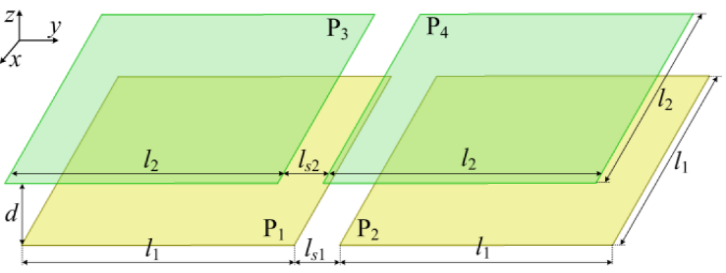


 Here, C1 = self-capacitance at primary sideC2 = Self- capacitance at secondary sideCM = Mutual capacitance
Here, C1 = self-capacitance at primary sideC2 = Self- capacitance at secondary sideCM = Mutual capacitance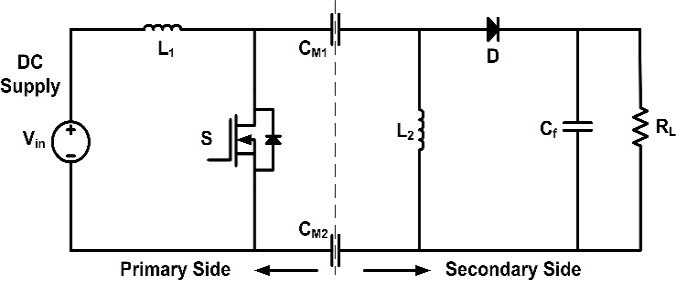
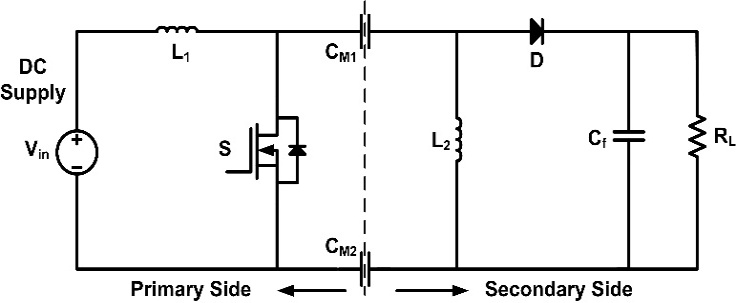
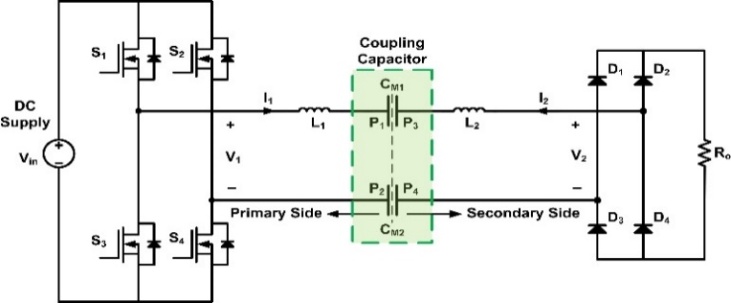
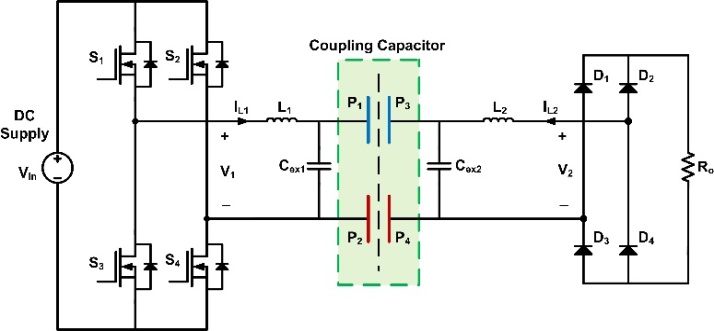
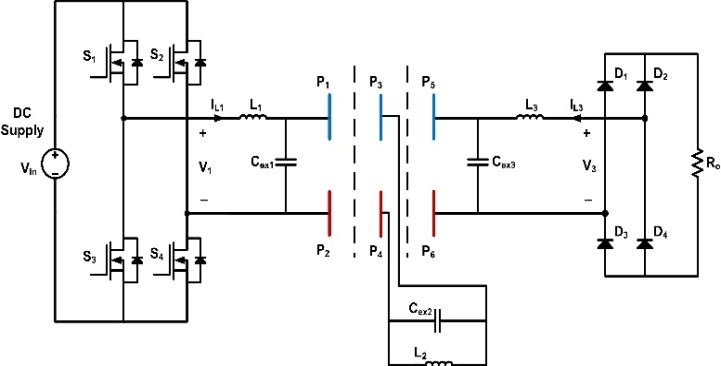
 The main limitation of this topology is the transfer efficiency especially in long distance applications. When the number of repeater stage increases, the power loss in the system could increase drastically.
The main limitation of this topology is the transfer efficiency especially in long distance applications. When the number of repeater stage increases, the power loss in the system could increase drastically.


 where ⍵0 is the switching frequency. The capacitors CM1, CM2, Cp and Cs form an equivalent capacitance at the primary side which can be written as,
where ⍵0 is the switching frequency. The capacitors CM1, CM2, Cp and Cs form an equivalent capacitance at the primary side which can be written as,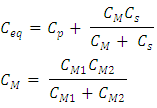 In Figure.12, the voltage on C2 is caused due to the capacitive coupling which can be written as,
In Figure.12, the voltage on C2 is caused due to the capacitive coupling which can be written as, The output current (-I2) to the load is,
The output current (-I2) to the load is, Similarly, the input current, I1 can be found as,
Similarly, the input current, I1 can be found as, From above two equations, we observed that the input current I1 is 900 lagging V2 and the V1 is also lagging –I2 by 900. So the input voltage V1 is in phase with the input current I1.The power transferred, Pout is,
From above two equations, we observed that the input current I1 is 900 lagging V2 and the V1 is also lagging –I2 by 900. So the input voltage V1 is in phase with the input current I1.The power transferred, Pout is, The main advantage of double-sided LCLC compensation circuit is that the system power is directly proportional to coupling coefficient. Moreover, in this topology without hampering coupling coefficient we can regulate system power through the circuit parameter design [40]. So, for efficiency consideration high coupling coefficient can be maintained fulfilling the power requirements. Again, as like the LC compensation circuit in this topology also we can reduce the resonant inductances L1 and L2 significantly by the help of the external capacitors Cex1 and Cex2.The disadvantage of this topology is its complexity. The system cost, weight as well as power loss is increased due to the presence of eight passive components in the circuit which eventually affects the system efficiency.
The main advantage of double-sided LCLC compensation circuit is that the system power is directly proportional to coupling coefficient. Moreover, in this topology without hampering coupling coefficient we can regulate system power through the circuit parameter design [40]. So, for efficiency consideration high coupling coefficient can be maintained fulfilling the power requirements. Again, as like the LC compensation circuit in this topology also we can reduce the resonant inductances L1 and L2 significantly by the help of the external capacitors Cex1 and Cex2.The disadvantage of this topology is its complexity. The system cost, weight as well as power loss is increased due to the presence of eight passive components in the circuit which eventually affects the system efficiency.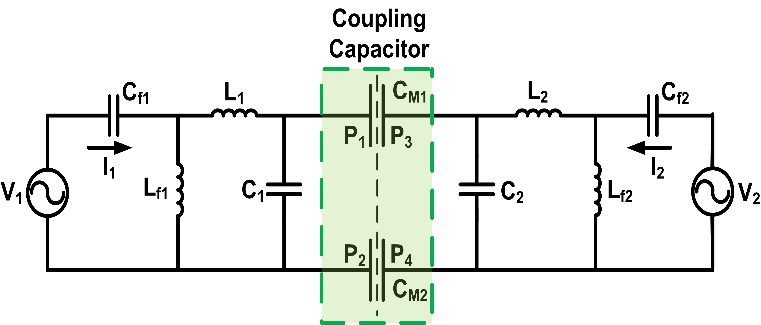
 Abstract
Abstract Reference
Reference Full-Text PDF
Full-Text PDF Full-text HTML
Full-text HTML
